Crush the fear economy
For the pandemic-related fear to be reversed, door-to-door delivery of cash, essential goods, health and psychosocial services need to be deployed


 Image: Shutterstock
Image: Shutterstock
It is not about bending the Corona Virus (COVID ) pandemic curve. It is not about preventing GDP growth rates from tumbling. It is also not about the pain of hollowed out job markets. At this moment in India and elsewhere, it is about crushing the fear economy curve created by the pandemic. And the epicentre of the fear economy is the household ( call it family if you want) .Yes , the proverbial household , the tacit space that everyone remembers only when a census operation is around the corner.
Unlike a Tsunami disaster where destruction of human lives and property is abrupt and where the central issue is about addressing the trauma of the survivors , COVID 19 is about the fear of falling a victim to an insidiously spreading virus . Also unlike a Tsunami or other disasters the COVID problem needs to be ‘contained’ and the onus for this rests with households. The Epidemic Diseases Act, 1897 which was brought in by the British Raj against the backdrop of the bubonic plague in Bombay, was a punitive law that was designed to regulate ‘people’. Though the National Disaster Management Act (NDMA) of 2005 is development and welfare oriented, its focus is only on ‘areas’ affected by disasters. By comparison , ‘The Containment Plan for Large Outbreaks Novel Coronavirus Disease 2019’ very recently released by the Union Ministry of Health and Family Welfare is a great leap forward as it mentions about targeting ‘families’ for psychosocial support. It is vital that the term ‘disaster management’ employed in the NDMA be extended to include in its ambit virus and bacteria triggered pandemics with families and households as focus points.
Paul Valery’s line ‘ We hope vaguely, but dread precisely’ sums the fear psychosis that tends to grip large number of households observing social distancing to quell COVID 19. At least four classes of fears are common to all , viz, the fear of getting infected by COVID , the fear of running out of purchasing power , fear of scarcity of essential goods and fears about the longevity of the pandemic. Other fears are specific to the social situation of households. Families of COVID warriors live in constant fear about their breadwinner’s life. Migrant workers and daily wagers are caught between fear of infection on the one hand and fear of irrevocable loss of livelihood on the other. India’s middleclass who are holed up inside their dwellings worry about the drain on their financial resources in the event of getting infected. Socialisers and ‘go outsiders’ who ‘ like to see and be seen’ (to cite Foucault ) swing from fear of infection to fear of losing out on their zest for life. Households with asymptomatic victims fear the social stigma of detection and enforced confinement.
What compounds fears of the type mentioned is the hide and seek play of the deadly virus. China’s successful lock down of Wuhan/ Hubei was the toast of sections of international media during the first week of March. It was contrasted with the clumsy partial lock down systems that Italy tried out and failed. However in early April, just when it looked that Wuhan was up and running came a spate of new incidents of infections, this time from asymptomatic cases. Such unexpected reversals evoke fears about the problem persisting endlessly.
In a recent issue of the New England Journal of Medicine, Harvey Fineberg writes that the corona pandemic would persist over a longer time frame than one would like to think. According to Fineberg economic recovery in COVID 19 affected countries will stretch even farther in time.
Every ounce of what Harvey has written is true. The proximate reason for slow economic recovery could be the lingering grip of the economics of fear amongst households concerned. Anecdotal evidence suggests that the COVID fear economy is characterised by patterns of economic behaviour that run contrary to the canons of rational consumer theory that underlie normal time economics. True, the lockdown regime in India has ensured door to door deliveries of PDS goods to Jan Dhan beneficiaries. It is equally interesting to see in certain localities, the emergence of informal social partnerships that ensure that supplies of essential goods are not disrupted.
However there are pockets where Jan Dhan families suffer from insufficient liquidity partly due to reluctance to spend and partly due to difficulties in accessing operate their accounts due to social distancing regulations. This coupled with discontinuance of ‘take delivery and pay later’ arrangements by small stores has left these vulnerable sections in a lurch. The other not so good lock down story is the failure of large e-commerce platforms to execute door to door deliveries. This has pushed their nervous customers to crowd at local physical stores resulting in panic buying and hoarding.
The net effect of the fear syndrome is the inertia to spend which causes household consumption to decline even when supply of essential goods is not constrained. This is a perverse state of affairs which if allowed to linger can delay the revival of the normal time economy in the post pandemic phase.
For the fear economy to be reversed door to door delivery of cash and essential goods needs to take place and a decisive decision is taken to draft India’s formidable army of unemployed doctors under the aegis of ‘Ayushman Bharat’ to provide door to door health and psychosocial services to households on the lines of family doctors system practised by Cuba.
There is more to this.
India’s Ayushman Bharat is holistically conceived as an integrated health and environmental sustainability approach to wellness. If the idea of household based family doctor system is permanently built into India’s Ayushman Bharat Plan, it will sow the seeds of an alternative bottom up growth model for the Indian economy that runs on robustly self-reliant local economies. This would then be one of most enduring upsides of the current crisis we are facing.
Views are personal.
*A. Damodaran is an Economics and Social Sciences professor at IIM Bangalore.
First Published: Apr 10, 2020, 11:46
Subscribe Now